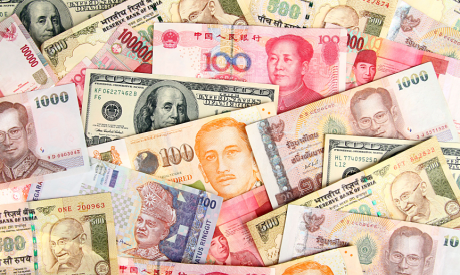Key Points
- We lower our USDPHP forecasts to 58.00 for 4Q2024 (from 58.70 previously), and to 57.50 for 2Q2025 (from 58.00 previously). These forecasts imply a modest downward bias for USDPHP at current levels, notwithstanding global drivers such as the upcoming Fed meeting, US Elections and global risk appetite.
- One element driving our view is that USDPHP has diverged from and overshot its close historical relationship with the trade deficit and the current account (see Chart 1 below). This is true even after factoring in our forecast for a gradually wider trade deficit. What’s driving this divergence may include increased RHS FX hedging activity, coupled with higher resident capital outflows.
- Nonetheless, with the FX and rates market much better priced for BSP rate cuts now, we think USDPHP should gradually move from divergence to converge to fundamentals due to three positive domestic supportive factors. First, inflation looks much more manageable stemming from rice import tariff cuts. Second, foreign direct investment (FDI) is set to rise further. Third, growth is expected to improve gradually which should support portfolio inflows over time.



We continue to forecast the BSP to cut rates by 50bps this year, possibly starting in the upcoming August policy meeting, and by another 50bps in 2025. This would bring the BSP’s policy rate to 5.50% by 2025 from 6.50% currently. We see the Philippines’ 10-year bond yields falling below 6% in 2025 with a modest steepening bias.
- PHP has underperformed meaningfully since April 2024: For comparison, PHP weakened by close to 4% against the Dollar, which was a far softer performance when compared with other lower yielding currencies such as TWD, KRW, and even JPY, with currencies such as MYR, THB and SGD strengthening during this period (see Chart 4 below).

- A key driver of this FX underperformance was likely sparked by a dovish change in tone by the central bank signalling a possible August rate cut, together with a perception that the central bank is intervening less in the FX market. Nonetheless, this is unlikely the full story as the central bank only officially changed its tone to signal a rate cut from the 16 May 2024 policy meeting, and PHP’s underperformance actually started quite a bit before that from April 2024.
- While it’s hard to know in real-time given the lags in data, we think there are two other reasons for the ongoing divergence between USD/PHP and underlying fundamentals. First, there may have been some pull forward in Dollar demand with increased RHS FX hedging activity (see Chart 2 above). Second, there could have been increased resident outflows in the Philippines, but the exact form that this takes historically in the Philippines tend to be in the form of under invoicing of imports, most notably between 2013 to 2014 (see Chart 5 below).

- Overall, with the FX and rates markets much better priced for BSP rate cuts now, we think USD/PHP may gradually converge to its fundaments. Our forecast for the current account and the trade deficit should imply USDPHP closer to the 56-57 levels if that is any guide, before gradually trending higher over the medium-term (Chart 1 and 5). We highlight three factors which could drive a modest move in USD/PHP from divergence to convergence.
- First, we expect inflation to step down more noticeably from August given the rice import tariff cuts from 35% to 15%. We note that year-on-year headline inflation in the Philippines has been mostly about sticky rice prices thus far (see Chart 7 below). In that regard, the recent rice import tariff cut from 35% to 15% was officially implemented on 5 July from Executive Order 62, and will likely be quite significant given the hefty 9% weight from rice in the Philippines CPI basket. We have seen some tentative signs of a downward trend in rice prices, with average daily rates falling to PHP55.38/kg as of 27 July from PHP56.38/kg on 5 July. We expect the trend of lower rice inflation to be more noticeable from August when the tariff cuts filter through from imports, and should at the very least cap any potential rice price increases moving forward.
- Second, we expect Foreign Direct Investment (FDI) to pickup more noticeably from 2H2024, reflecting the sharp surge in FDI approvals that we have already seen (Chart 9). This largely reflects rising interest in the utilities sector, which we believe is due to increased investments in the renewables given relaxation of foreign ownership requirements in green energy. Rising actual FDI should help support PHP and fund the wider trade deficit and higher imports needs that we forecast in the Philippines.
- Third, we expect growth to improve gradually over time, given more manageable inflation pressures, a resilient labour market, rising investment approvals, pickup in bank credit, coupled with a supportive fiscal stance. We note that the government has maintained a commitment to fiscal consolidation over the medium-term, but has slowed the forecasted pace of consolidation from now till 2028. The fiscal deficit is now estimated at 5.6% of GDP for 2024 (from 5.1% previously), while declining over time to 3.7% of GDP in 2028 (from 3% previously). Overall, this means that the Philippines fiscal stance is now more supportive of growth, which together with other factors such as lower inflation and a modest pickup in minimum wages should support growth.


- Nonetheless, we think a sharp PHP rebound like what we saw from 4Q2018 to 2019 is unlikely. For one, PHP is in a different part of the cycle, with the current account deficit likely to widen from here. This is unlike in 4Q2018 when the deficit narrowed meaningfully driven in part from lower government expenditure (see Chart 11). In addition, FX valuations as denoted by the deviation of the Real Effective Exchange Rate (REER) from the long-term average is not cheap in absolute terms, even as it is cheaper than before (see Chart 12). Last but not least, there are also some risks to watch for, including the impact to growth and inflation from Typhoon Carina, coupled with the recent ban on Philippines Offshore Gaming Corporations (POGOs). Official estimates peg the economic benefits from POGOs at 0.2% of GDP (Chart 13).




